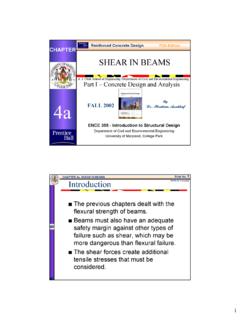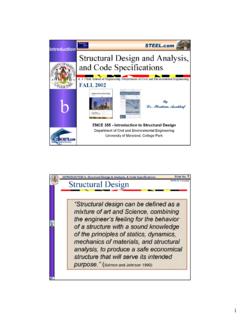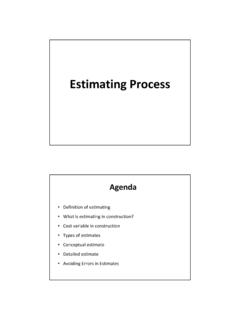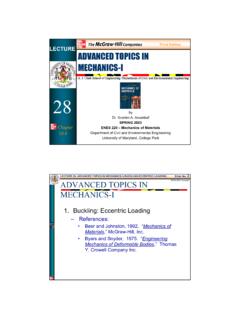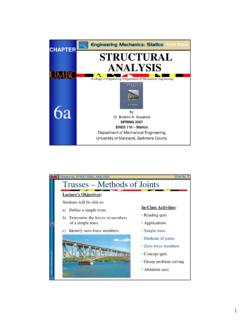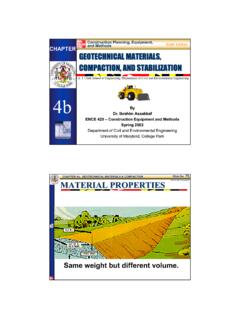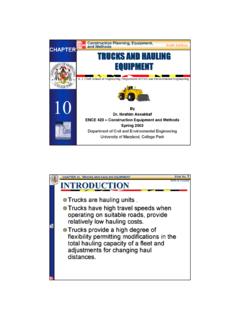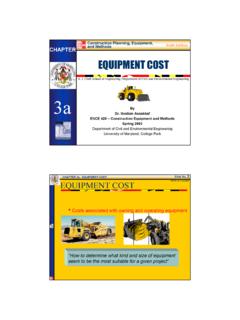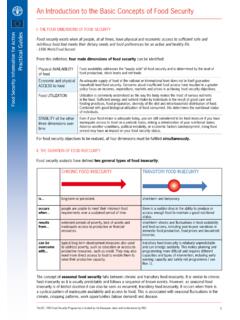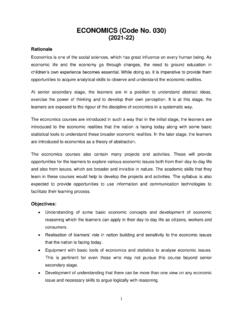Transcription of INTRODUCTION TO ENGINEERING ECONOMICS
1 1 A. J. Clark School of ENGINEERING Department of Civil and Environmental EngineeringINTRODUCTION TO ENGINEERING AssakkafENCE 202 Spring 2000 Department of Civil and Environmental EngineeringUniversity of Maryland Dr. AssakkafSlide No. 2 A. J. Clark School of ENGINEERING Department of Civil and Environmental EngineeringENCE 202 Eng. EconHandout 6 IntroductionnDefinition of EngineeringEngineering is the profession in which knowledge (math and natural sciences gained by study, experience and practice) is applied with judgment to develop ways to utilize, economically, the materials and forces of nature for the benefit of AssakkafSlide No. 3 A. J. Clark School of ENGINEERING Department of Civil and Environmental EngineeringENCE 202 Eng. EconHandout 6 IntroductionnTwo environments are needed for the work of an engineer physical and economical environmentsnAn engineer needs to establish efficiency in both environments that are not independentDr.
2 AssakkafSlide No. 4 A. J. Clark School of ENGINEERING Department of Civil and Environmental EngineeringENCE 202 Eng. EconHandout 6 IntroductionnEngineering Process Determination of objectives Identification of strategic factors Determination of means ( ENGINEERING proposals) Evaluation of ENGINEERING proposals Assistance in decision making3Dr. AssakkafSlide No. 5 A. J. Clark School of ENGINEERING Department of Civil and Environmental EngineeringENCE 202 Eng. EconHandout 6 IntroductionnEngineering economic Studies Creative step Definition step Conversion step to same scale to facilitate comparative evaluation Decision stepDr. AssakkafSlide No. 6 A. J. Clark School of ENGINEERING Department of Civil and Environmental EngineeringENCE 202 Eng. EconHandout 6 IntroductionnEXAMPLES: Infrastructure expenditure decision Replace versus repair decisions Selection of inspection method Selection of a replacement for an equipment4Dr.
3 AssakkafSlide No. 7 A. J. Clark School of ENGINEERING Department of Civil and Environmental EngineeringENCE 202 Eng. EconHandout 6 Fundamental economic ConceptsnEconomics deals with the behavior of peoplenUtility Utility is the power of a good or service to satisfy human needs Dr. AssakkafSlide No. 8 A. J. Clark School of ENGINEERING Department of Civil and Environmental EngineeringENCE 202 Eng. EconHandout 6 Fundamental economic ConceptsnValue Value designate the worth that a person attaches to an object or service Value is a measure or appraisal of utility in some medium of exchange. Value is not the same as cost or price5Dr. AssakkafSlide No. 9 A. J. Clark School of ENGINEERING Department of Civil and Environmental EngineeringENCE 202 Eng. EconHandout 6 Fundamental economic ConceptsnConsumer and Producer Goods Consumergoods are the goods and services that directly satisfy human wants.
4 For example, TV, shoes, houses. Producergoods are the goods and services that satisfy human wants indirectly as a part of the production or construction process. For example, factory equipment, industrial chemicals ands AssakkafSlide No. 10 A. J. Clark School of ENGINEERING Department of Civil and Environmental EngineeringENCE 202 Eng. EconHandout 6 Fundamental economic ConceptsnThe Utilities of Goods Consumer goods:Basic human needs of food, clothing and shelter. In commercial advertisements, emphasis is given to senses not reasoning. The utility in this case is considered objectively and/or subjectively. Producer goods:The utility stems for their means to get to an end. The utility in this case is considered AssakkafSlide No. 11 A. J. Clark School of ENGINEERING Department of Civil and Environmental EngineeringENCE 202 Eng.
5 EconHandout 6 Fundamental economic ConceptsnEconomy of Exchange Economy of exchange occurs when utilities are exchanged by two or more people. It is possible because consumer utilities are evaluated subjectively. Mutual benefit in exchange Persuasion in exchange. SalespersonDr. AssakkafSlide No. 12 A. J. Clark School of ENGINEERING Department of Civil and Environmental EngineeringENCE 202 Eng. EconHandout 6 Fundamental economic ConceptsnEconomy of Organization Through organizations, ends can be attained or attained more economically by:1. Labor saving2. Efficiency in manufacturing or capital use7Dr. AssakkafSlide No. 13 A. J. Clark School of ENGINEERING Department of Civil and Environmental EngineeringENCE 202 Eng. EconHandout 6 Fundamental economic ConceptsnClassification of Cost (cont d) First (or initial) cost:Cost to get activity started such as property improvement, transportation, installation, and initial expenditures) Operation and maintenance cost:They are experienced continually over the useful life of the activityDr.
6 AssakkafSlide No. 14 A. J. Clark School of ENGINEERING Department of Civil and Environmental EngineeringENCE 202 Eng. EconHandout 6 Fundamental economic ConceptsnClassification of Cost (cont d) Fixed cost:It does not depend on output volume (cost of management for example). Variable cost:It is per unit produced. Incremental or marginal cost:Cost per unit or production increase. It is determined from the variable AssakkafSlide No. 15 A. J. Clark School of ENGINEERING Department of Civil and Environmental EngineeringENCE 202 Eng. EconHandout 6 Fundamental economic ConceptsnClassification of Cost (cont d) Sunk cost:It cannot be recovered or altered by future actions. Usually this cost is not a part of ENGINEERING economic analysis. Life-cycle cost:Feasibility, design, construction, operation and disposal costsDr.
7 AssakkafSlide No. 16 A. J. Clark School of ENGINEERING Department of Civil and Environmental EngineeringENCE 202 Eng. EconHandout 6 Fundamental economic ConceptsnSupply and Demand Demand curve shows the number of units people are willing to buy and cost per unit (decreasing curve). Supply curve shows the number of units that vendors will offer for sale and unit price (increasing curve). The intersection defines the exchange AssakkafSlide No. 17 A. J. Clark School of ENGINEERING Department of Civil and Environmental EngineeringENCE 202 Eng. EconHandout 6 Fundamental economic ConceptsnSupply and Demand (cont d) Elasticity of demand. Price changes and their effect on demand changes. It depends on whether the consumer product is a necessity or a luxury. Law of diminishing return. A process can be improved at a rate with a diminishing return.
8 Example: cost of inspection to reduce cost of repair and lost AssakkafSlide No. 18 A. J. Clark School of ENGINEERING Department of Civil and Environmental EngineeringENCE 202 Eng. EconHandout 6 Fundamental economic ConceptnThe Interest Rate Called also the rate of capital growth, it is the rate of gain received from an investment. It is expressed on an annual basis. For the lender, it consists, for convenience, of (1) risk of loss, (2) administrative expenses, and (3) profit or pure gain. For the borrower, it is the cost of using a capital for immediately meeting his or her AssakkafSlide No. 19 A. J. Clark School of ENGINEERING Department of Civil and Environmental EngineeringENCE 202 Eng. EconHandout 6 Fundamental economic ConceptsnThe Time Value of Money (TVM) As a result of the earning power of money (through interest), time increases the purchasing power of money by its increase through earningDr.
9 AssakkafSlide No. 20 A. J. Clark School of ENGINEERING Department of Civil and Environmental EngineeringENCE 202 Eng. EconHandout 6 Fundamental economic ConceptsnThe Time Value of Money (TVM) Money has a time value One dollar today is worth more than $1 tomorrow Failure to pay the bills results in additional charge termed interest11Dr. AssakkafSlide No. 21 A. J. Clark School of ENGINEERING Department of Civil and Environmental EngineeringENCE 202 Eng. EconHandout 6 Fundamental economic ConceptsnThe interest i Interest is usually expressed as a percentage of the amount owed It is due and payable at the close of each period of time involved in the agreed transaction (usually every year or month). Dr. AssakkafSlide No. 22 A. J. Clark School of ENGINEERING Department of Civil and Environmental EngineeringENCE 202 Eng.
10 EconHandout 6 Fundamental economic ConceptsnThe interest i EXAMPLE: If $ 1, is borrowed at 14% interest, then interest on the principal of $ 1, after one year is x 1, 000, or $ If the borrower pays back the total amount owed after one year, she will pay $1, 12Dr. AssakkafSlide No. 23 A. J. Clark School of ENGINEERING Department of Civil and Environmental EngineeringENCE 202 Eng. EconHandout 6 Fundamental economic ConceptsnThe interest i EXAMPLE (cont d): If she does not pay back any of the amount owed after one year, then normally the interest owed, but not paid, is considered now to be additional principal, and thus the interest is compounded After two years she will owe $1, + X 1, ,or 1, Dr. AssakkafSlide No. 24 A. J. Clark School of ENGINEERING Department of Civil and Environmental EngineeringENCE 202 Eng.

